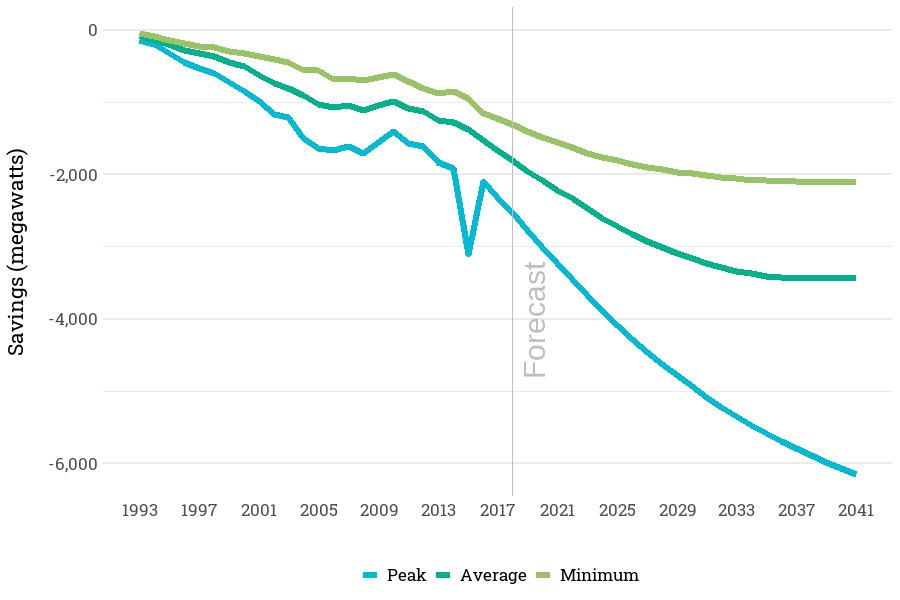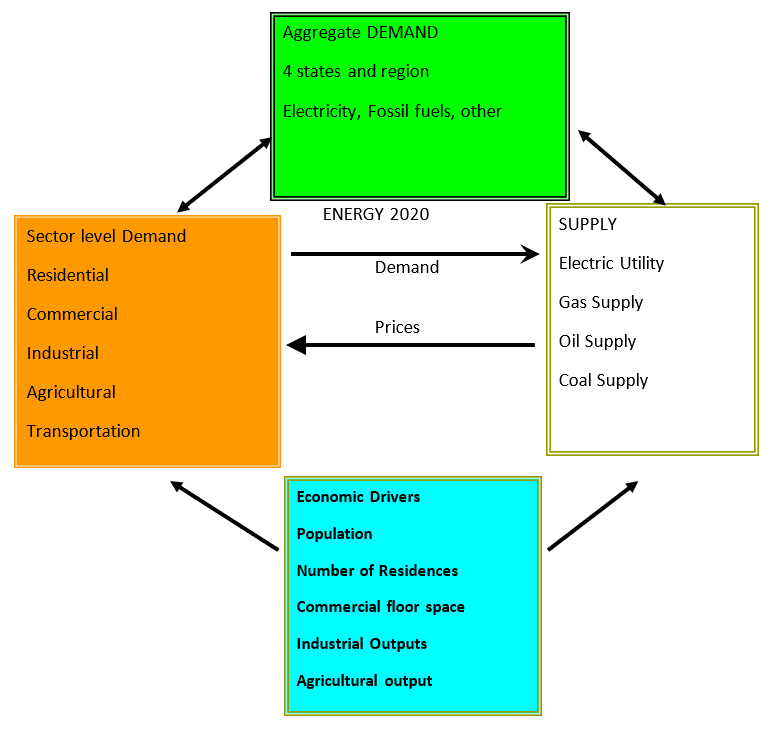The Council uses an aggregation of multiple models and methods to forecast the energy use for the region. Different types of forecasts are created depending how they are used in the process of developing the plan.
Creating a Forecast Range
To create a range of load forecasts, three sets of economic drivers are used: trend or base, optimistic (high), and pessimistic (low). The economic drivers translate into increased or decreased energy use by changing a projection on elements in the Energy2020 model like the commercial floor space required. Under each of these three economic-driver-based forecasts we also examine three different climate-change-based forecasts. This gives us 9 different combinations showing a range of economic and climatic conditions. This is done separately for each state and then aggregated to a regional forecast.
Types of Forecasts
The Council’s Demand Forecasting System, Energy2020, produces three types of forecasts: price-effect forecast, Frozen efficiency forecast, and sales forecast.
- Price-effect” forecast: The price-effect forecast reflects customers’ choices in response to electricity and fuel prices and technology costs, without any new conservation initiatives. This forecast does not include new conservation resources. However, expected savings from existing and approved codes and standards are incorporated in the price-effect forecast, consequently reducing the forecast and removing the potential from the new conservation supply curves.
- Frozen-efficiency forecast. A “frozen-efficiency” forecast is calculated based on fixed or frozen efficiency levels as of the base year of the plan. This forecast attempts to eliminate the double-counting of conservation savings. The frozen technical-efficiency levels form the conservation supply model’s starting point. In the frozen-efficiency forecast, the fuel efficiency choice is held constant at the base-year level and not changed over time, except where there is a known increase due to codes or standards.
- Sales forecast. A “Sales”[1] forecast represents the expected sales of electricity after all cost-effective conservation has been achieved. It incorporates the effects of electricity prices and the cost-effective conservation resources that are selected by the regional portfolio model. The sales forecast captures both price effects and take-back effects (due to increased usage as efficiency of usage increases).
The difference between the price-effect and frozen-efficiency load forecasts is relatively small. The frozen-efficiency forecast typically is higher than the price-effect forecast.
Incorporating the Impact of Codes and Standards
Federal and State codes and standards have and will continue to have a major impact in keeping loads lower than would have been in the absence of standards. To capture impact of these codes and standards we ran the Council’s long-term model twice, once with codes and standards and once without. The delta between the model load forecast indicates a counter-factual assessment of the impact of codes and standards. Codes and standards impact sectors, end-uses and fuels.
Impact on Electricity Use
The figure below shows an estimate of the impact of federal standards and state building codes as of 2019. Without the federal standards, we estimate that by 2041 loads would have been higher by over 3400 average megawatts. In addition, peak loads are lower by over 6500 MW. Note that impact of codes and standards are not static. Over time as consumer decisions of appliance efficiency may exceed codes and standards in-effect. At that point a given code or standard would not lower the demand. Also, impacts for 1990-2018 include impact of observed temperatures in the historic period. Impacts for 2019-2050 incorporate impact of future temperature conditions. The figure and tables below show results at regional level and for medium economic scenario.
Impact of Codes and Standards on Electric Demand

Estimated Impact of State Codes and Federal Standards on Electricity Use by Sector
| Energy aMW | 1993 | 2018 | 2022 | 2041 | 2050 |
| Residential | (46) | (531) | (882) | (1,532) | (1,354) |
| Commercial | (3) | (580) | (716) | (1,182) | (1,249) |
| Industrial | (24) | (561) | (595) | (562) | (525) |
| Irrigation | (7) | (130) | (143) | (155) | (157) |
| Peak MW | 1993 | 2018 | 2022 | 2041 | 2050 |
| Residential | (110) | (1,038) | (1,808) | (4,197) | (4,744) |
| Commercial | (0) | (658) | (998) | (2,398) | (2,565) |
| Industrial | (31) | (704) | (747) | (708) | (665) |
| Irrigation | (16) | (304) | (337) | (380) | (391) |
Impact on Direct Natural Gas Use
Building codes and appliance standards applicable to natural gas fueled applications can also reduce demand for natural gas. Comparing regional demand for natural gas with and without the standards, we estimate that demand for natural gas in 2018 would have been higher by 41 TBTU if codes and standards were not put into effect. Reduction in demand is projected to continue until 2027 after which reduction in demand slows down, mainly due to gradual technological improvements in efficiency of appliances available in the market.
Impact of Codes and Standards on Demand for Natural Gas (TBTU)
Methodology to Incorporate Climate Change into Load Forecast Models
Climate change impacts the load forecast in several ways. Incorporating direct and indirect impacts of climate change in the planning framework of the 2021 Power Plan has been a major undertaking for this plan. How to incorporate climate change in the modeling framework required a two-prong approach, using both the long-term and short-term models.
Long-term Monthly Model (monthly time-steps weather normalized)
After selecting climate change models that covered a reasonable range of variation in forecast of temperature and precipitation. We calculated the monthly cooling and heating degree days for each GCM. Long-term load forecasting models typically assume average or normal weather conditions in the future. Climate Change forecasting models deal with variations from the normal. The long-term model can simulate load under various economic and temperature conditions. To simulate the impact of temperature on load, the model uses average monthly Cooling Degree Days and Heating Degree Days (base 65 degrees). Demand for space conditioning and water heating is modified based on future CDD and HDD. Given average monthly CDD and HDD for each GCM, the model produces a monthly weather normalized load forecast at state and regional levels. A monthly weather-normalized regional forecast then is converted to hourly loads under different future weather patterns using Council’s Short-term hourly model.
Short-term Hourly Model (Hourly time-steps subject to variations in weather)
Using an hourly model structure (Short-term Model, STM), the monthly load forecast from Energy2020 is converted to an hourly load forecast. Prior to 2020, STM model had used historic temperature years to study load impacts of past temperature profiles on estimated future loads. This was mainly because there was no long-term forecast of weather conditions. However, now, it is possible to have a trajectory for future daily minimum and maximum temperatures from Global Circulation Models (GCM’s). There are a variety GCM or Climate Change Model’s (CCMs) that produce daily min and max temperature projections. In 2020, and as part of 2021 Power Plan, the model was required to incorporate projections of future temperatures.
The STM produces two sets of outputs: weather normalized and temperature sensitive. A set of hourly weather normalized loads are forecasted and then modified based on a set of temperature sensitivity multipliers that reflect change in loads due to variations in temperature. For a given future year, say 2032, the model produces hourly loads for 2032 under normal weather patterns then it subjects this forecast to 30 different hourly weather patterns projected for years 2020 to 2049. This full range of hourly load forecasts are then used for resource adequacy analysis.
Model Enhancements for this Power Plan
The 2000-2001 Western energy crisis created renewed interest in demand forecasting, and the Northwest’s changing load shape has created a concern about capacity supply. In order to forecast these peaks, the Council relies on end-use forecasting models. Starting with its Sixth Power Plan, the Council selected a new end-use forecasting and policy analysis tool. The new DFS, based on the Energy 2020 model, generates forecasts for electricity, natural gas, and other fuel.
The Energy 2020 model is fully integrated and includes fuel, sectors, and end-use load. The Council uses Energy 2020 to forecast annual and peak load for electricity as well as for other fuels. The following flow-chart provides an overview of the Energy 2020 model.
Overview of Council's Long-Term Forecasting Model

The basic version of Energy 2020 was expanded to make sure that the DFS can meet the needs of conservation resource planning. The number of sectors and end-uses was increased. In the residential sector, three building types, four different space-heating technologies, and two different space-cooling technologies, four different water heating types and sizes were tracked. Demand was tracked for electricity for 12 end-uses in the residential sector. New end-uses were added, like information, communication, and entertainment (ICE) devices, which in earlier forecasts did not have a major share of electricity consumption in homes. Technology trade-off curves were updated with new cost and efficiency data.
In the commercial sector, the model was expanded to forecast load for 18 different commercial building types. Forecasts for commercial floor space development made sure that the economic drivers of the demand forecast for electricity and the economic drivers for the conservation resource assessment were identical.
The industrial sector of the model was updated with new regional energy consumption data. The work on the industrial sector is ongoing and the results of a recent analysis on industrial demand for electricity were added to the demand forecast. The load shape forecasting system was updated with the best available data on end-use load shape from recent Residential Building Stock Assessment (RBSA). This will enable the Council to demonstrate a closer link among the demand forecasting system, the hydro modeling, and the Regional Portfolio Model (RPM).
For this Plan, four major modules of the model were enhanced;
[1] The “sales” forecast, as well as price-effect and frozen efficiency, can be measured at a consumer or generator site (which would include transmission and distribution losses). Demand is measured at the customer site, and load is measured at the generator site.



